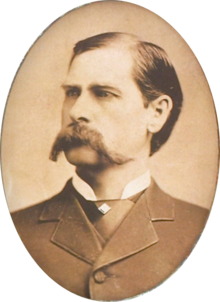
A revolver is a repeating handgun that has at least one barrel and uses a revolving cylinder containing multiple chambers for firing. Because most revolver models hold up to six cartridges, before needing to be reloaded, revolvers are commonly called six shooters or sixguns. Due to their rotating cylinder mechanism, they may also be called wheel guns.

The Colt Single Action Army is a single-action revolver handgun. It was designed for the U.S. government service revolver trials of 1872 by Colt's Patent Firearms Manufacturing Company and was adopted as the standard-issued revolver of the U.S. Army from 1873 to 1892.

The Smith & Wesson Model 10, previously known as the Smith & Wesson .38 Hand Ejector Model of 1899, the Smith & Wesson Military & Police or the Smith & Wesson Victory Model, is a K-frame revolver of worldwide popularity. In production since 1899, the Model 10 is a six-shot, .38 Special, double-action revolver with fixed sights. Over its long production run it has been available with barrel lengths of 2 in (51 mm), 3 in (76 mm), 4 in (100 mm), 5 in (130 mm), and 6 in (150 mm). Barrels of 2.5 inches (64 mm) are also known to have been made for special contracts. Some 6,000,000 of the type have been produced over the years, making it the most-produced handgun of the 20th century.

In American English, a pocket pistol is any small, pocket-sized semi-automatic pistol, and is suitable for concealed carry in a pocket or a similar small space.
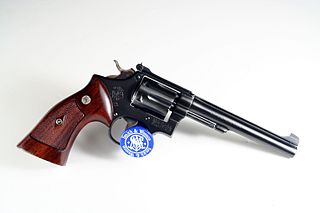
The Smith & Wesson K-22 Target Masterpiece Revolver is a six-shot, double-action revolver with adjustable open sights, built on the medium-size "K" frame. When introduced, it was intended for bullseye target shooting competition of the type then most common on the United States, which is today called NRA Precision Pistol, specifically in the "smallbore" or "22" category. It is chambered for the .22 Long Rifle cartridge. It is one of three similar models that Smith & Wesson offered, the other two being intended for the "centerfire" category, the K-32 Target Masterpiece chambered for the .32 S&W Long cartridge and the K-38 Target Masterpiece chambered for the .38 Special cartridge. Most K-22 revolvers were fitted with a 6 in (150 mm) or 8+3⁄8 in (210 mm) barrel, but other lengths have been produced. First produced in 1947 and originally known as the K-22 Target Masterpiece, it was numbered the Model 17 in 1957 when all Smith & Wesson guns were given numerical model numbers. It is built on the same frame as the seminal Smith & Wesson Model 10 revolver.

The Smith & Wesson Model 3 is a single-action, cartridge-firing, top-break revolver produced by Smith & Wesson (S&W) from around 1870 to 1915, and was recently again offered as a reproduction by Smith & Wesson and Uberti.

A snubnosed revolver is a small, medium, or large frame revolver with a short barrel, generally less than 3 inches in length. Smaller such revolvers are often made with "bobbed" or "shrouded" hammers and there are also "hammerless" models ; the point is to allow the gun to be drawn with little risk of it snagging on clothing. Since the external movement of the mechanism is minimal or nil, shrouded and hammerless models may be fired from within clothing. The design of these revolvers compromises range and accuracy at a distance in favor of maneuverability and ease of carry and concealment.

The Colt Diamondback is a revolver manufactured by Colt's Manufacturing Company of Hartford, Connecticut, in calibers of .22 LR and .38 Special. Inspired by the successful Colt Python, the Diamondback was manufactured from 1966 to 1988 and was available in barrel lengths of 2½, 4, and 6 inches.
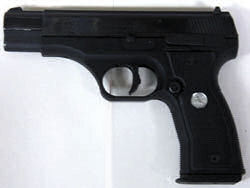
The Colt 2000 or All American 2000 is a polymer or aluminum-alloy framed, locked-breech, rotating barrel, semiautomatic, 9 mm handgun with a magazine capacity of 15 rounds manufactured by Colt.

A handgun is a firearm designed to be usable with only one hand. It is distinguished from a long barreled gun which needs to be held by both hands and braced against the shoulder. Handguns have shorter effective ranges compared to long guns, and are much harder to shoot accurately. While most early handguns are single-shot pistols, the two most common types of handguns used in modern times are revolvers and semi-automatic pistols, although other handguns such as derringers and machine pistols also see infrequent usage.

Wyatt Earp: Frontier Marshal (1931) was a best-selling biography of Wyatt Earp written by Stuart N. Lake and published by Houghton Mifflin Company. It was the first biography of Earp, written with his contributions. It established the Gunfight at the O.K. Corral in the public consciousness and conveyed an extraordinary story about Wyatt Earp as a fearless lawman in the American Old West. Earp and his wife Josephine Earp tried to control the account, threatening legal action to persuade Lake to exclude Earp's second wife from the book. When the book was published, neither woman was mentioned.

The Ruger Vaquero is a six-shot single-action revolver manufactured by Sturm, Ruger & Co. based on the New Model Ruger Blackhawk frame and was introduced in 1993. It comes in blued steel, case colored, and a gloss stainless finish, all of which are available with wood, hard rubber, simulated ivory or black micarta grips and fixed sights. It arose with the popularity of Cowboy Action Shooting from which came demand for a single-action revolver that was more traditional in appearance.

The Colt New Service is a large frame, large caliber, double-action revolver made by Colt from 1898 until 1941. Made in various calibers, the .45 Colt version with a 5½" barrel, was adopted by the U.S. Armed Forces as the Model 1909.

The Ruger Old Army is a black-powder percussion revolver introduced in 1972 by the Sturm, Ruger company and manufactured through 2008. Models were made with a 7.5" and a 5.5 inch barrel.
Chiappa Firearms, Armi Sport di Chiappa, is an Italian firearms manufacturing company based in Brescia. It was founded in 1958 by Ezechiele Chiappa as Armi Sport. Total unit production is around 60,000 per year. Its U.S. headquarters are in Dayton, Ohio.
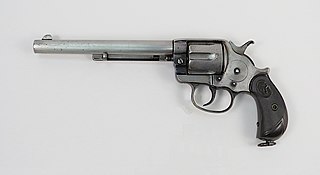
The Colt M1878 is a double-action revolver that was manufactured by Colt's Manufacturing Company from 1878 until 1907. It is often referred to as the "Frontier" or the "Double Action Army" revolver. A total of 51,210 Model 1878 revolvers were manufactured, including 4,600 for the US Ordnance Department. These are known as the "Philippine" or "Alaskan" models.
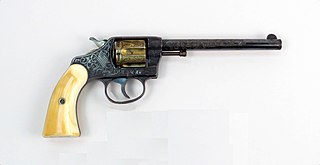
The Colt New Police is a double-action, six-shot revolver. This gun was chambered in the .32 New Police, which is very similar to the .32 S&W Long. In addition to the .32 New Police cartridge, the revolver was available in 32 Colt.
Cimarron Firearms is an American firearms importer that has been in operation since 1984. The company's field of specialty is reproduction firearms from the American Civil War to the end of the Old West period. Founded by Mike Harvey in Houston, Texas, the company is now based in Fredericksburg, Texas.
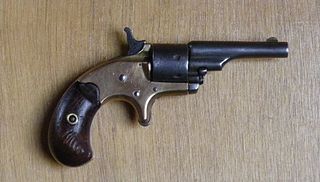
The Colt Open Top Pocket Model Revolver was a single action pocket revolver introduced by the Colt's Patent Fire Arms Manufacturing Company in 1871. Introduced a year before the Colt Open Top and two years before the Colt Peacemaker and the Colt New Line, the Colt Open Top Pocket Model Revolver was, alongside the Colt House Revolver, one of the two first metallic cartridge rear-loading revolvers manufactured by Colt's. It also was one of the first pocket metallic cartridge revolvers made by the company.

Wyatt Earp was an American Old West lawman and gambler in Cochise County, Arizona Territory, and a deputy marshal in Tombstone, Arizona Territory.

